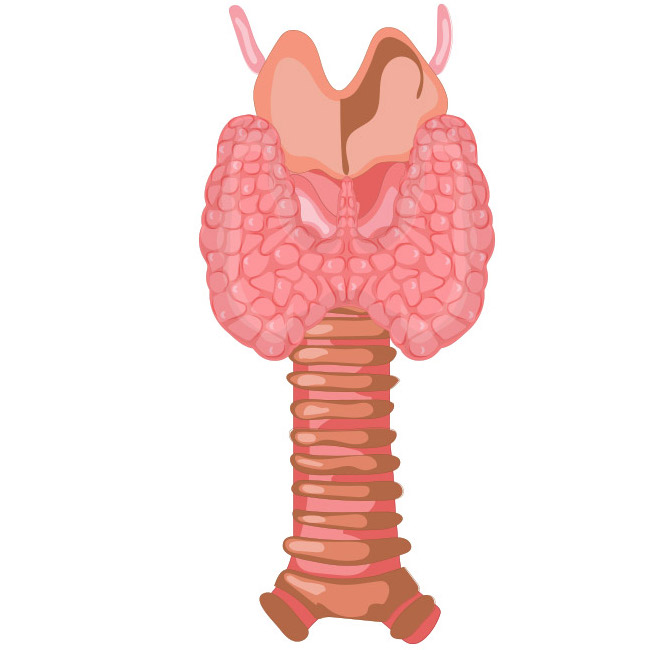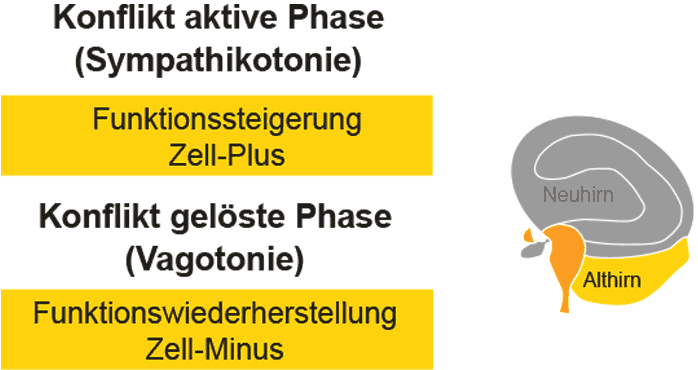Hyperthyroidism and hypothyroidism: bio-logic can be used to understand function and cell change processes
The thyroid gland controls hormone metabolism, with the hormones acting as mediators to control the various organs and tissues. The thyroid hormone thyroxine in particular controls the activity of our entire organism: more thyroxine accelerates, less thyroxine slows down the overall metabolism.

An increase in performance and metabolic acceleration is achieved by an overactive thyroid (increased production of the hormone thyroxine).
A slowdown and reduction in performance (hypothyroidism) occurs when less thyroxine enters the bloodstream. In this case, there may be a reduced production of the hormone thyroxine or the ducts that release the hormone into the blood may be narrowed or blocked.

The thyroid tissue belongs to the endoderm germ layer. Entodermal tissue is controlled by the brain stem and leads to an increase in function (increased production of the hormone thyroxine) in the conflict-active phase. If the hyperfunction is not sufficient to resolve the conflict, cell proliferation also occurs.
Hyperthyroidism = conflict-active phase
Other terms that correspond to the conflict-active phase: Graves’ disease, goitre, thyroid cancer, hot nodule
Hyperthyroidism leads to increased production and release of the thyroid hormone thyroxine into the blood. This hyperfunction and increased production generally leads to an increase in metabolism and hyper-excitability of the entire organism.
- Biological sense: ‘I’m not fast enough’ to get rid of an unwanted lump more quickly. Metabolism is increased in order to become faster
- Conflict-active phase: A compact, cauliflower-like adeno-ca (cell proliferation) grows here, a so-called hard goitre with hyperthyroidism (increased thyroxine production) or thyrotoxicosis (Graves’ disease)
Hypothyroidism = conflict-resolved phase
Other terms that correspond to the conflict-resolved phase: Myxoedema, Hashimoto’s thyroiditis, cold nodule
In the repair phase/conflict-resolved phase, thyroxine production is reduced. The internal metabolism is slowed down or inhibited. The ducts that release the hormones into the blood can become ‘blocked’ by a cystic obstruction, with the result that fewer hormones (thyroxine) are released into the blood.
- Conflict-resolved phase: In the repair and healing phase, the cysts slowly swell or become less if there are no recurrences.
In the conflict-resolved phase, the previously increased tissue is broken down by bacteria / fungal bacteria. Once the process has been successfully completed, the normal function of thyroid hormone production is restored.
Recurring processes (recurrences / pending healing) with conflict activity and conflict resolution lead in the long term to chronic processes with scarring, whereby the inflammation and swelling processes are always attempts by the body to repair itself.
Whether hyper- or hypofunction: sequence of the bio-logical conflict
The bio-logical purpose (only affects the glandular tissue) of hyperthyroidism is to increase the metabolism by producing and excreting more thyroxine in order to get rid of an unwanted ‘lump’ more quickly. The overall metabolism is activated and accelerated.
In the conflict-active phase, a compact cauliflower-like adeno-ca (cancer = cell proliferation, never malignant!) grows, a so-called hard goitre, with hyperthyroidism (increased production of thyroxine) or thyrotoxicosis (Graves’ disease). The increased production and release of thyroxine increases the metabolism and the individual can act and react more quickly. This also leads to the formation of cysts.
The cysts usually swell, but normally slowly recede during the repair and healing phase (conflict-resolved phase) – provided that no new recurrences occur and the patient does not fall into a so-called vicious circle. It may be possible for these excretory tubes to stick together and fuse, i.e. remain closed. Such ‘end stages’ are basically harmless as a symptom, i.e. the patient can live to be 100 years old.
Chemotherapy interrupts the repair process of the ducts/cysts and the swelling is reduced. After chemotherapy, however, the repair processes occur again, leading to swelling and drainage problems.
Patients with a retrosternal goitre (cyst in the mediastinal area) are often recommended major thoracic surgery in order to access the mediastinum (space in the chest cavity). Even the announcement of the operation is a new conflict shock for many patients, especially an attack-conflict against the chest cavity that is to be opened, whereupon a so-called pleural mesothelioma (in conventional medicine: ‘metastasis’) develops. This perceived attack against the chest cavity that is to be opened is the cause of the pleural mesothelioma – a misinterpreted metastasis.
Many diagnoses, one explanation
Various ‘diseases’ of the thyroid gland can be clearly explained by these two phases. In Part 2 (coming soon), we look at the following diagnoses from a higher-level bio-logical perspective
- Graves’ disease (hyperthyroidism)
- Myxoedema/hypothyroidism (repair phase, hypothyroidism)
- Hashimoto’s thyroiditis (repair phase, hypothyroidism)
- Goitre (hyperthyroidism)
- Thyroid cancer (cell proliferation, hyperthyroidism)
- Cold nodule (repair phase, hypothyroidism)
- Hot nodule (hyperthyroidism)
Reading tip: Find out how hyperparathyroidism can lead to osteoporosis


